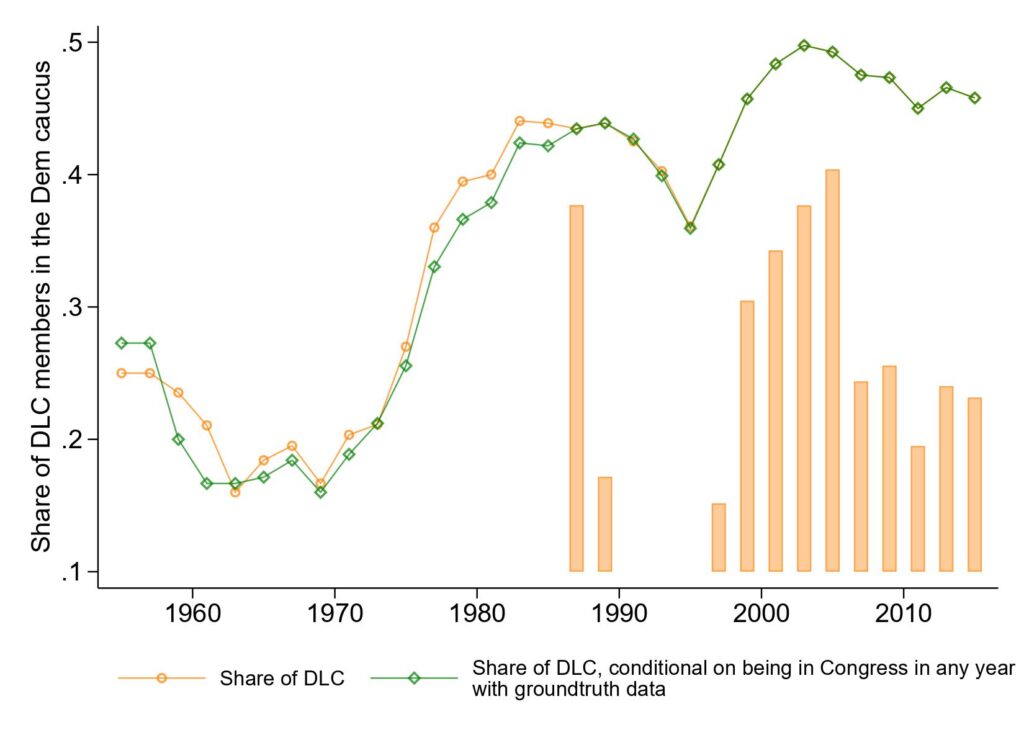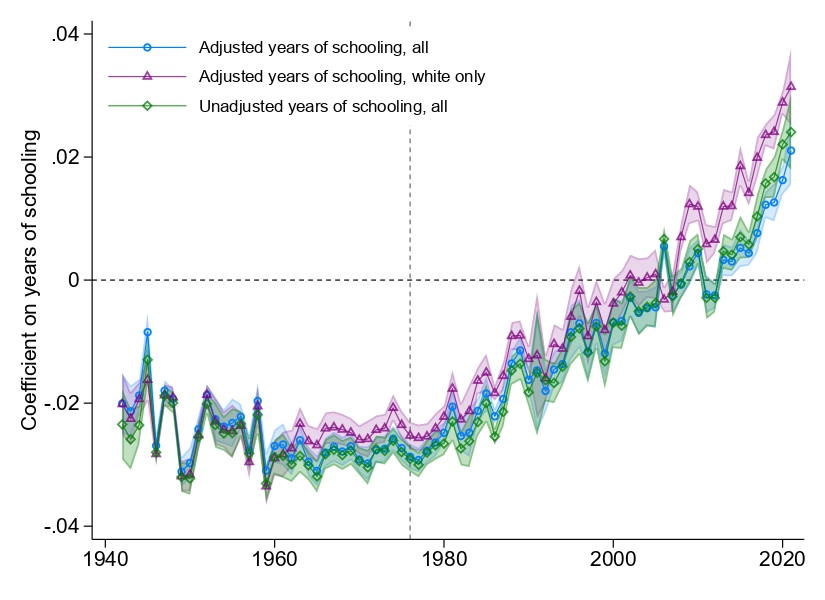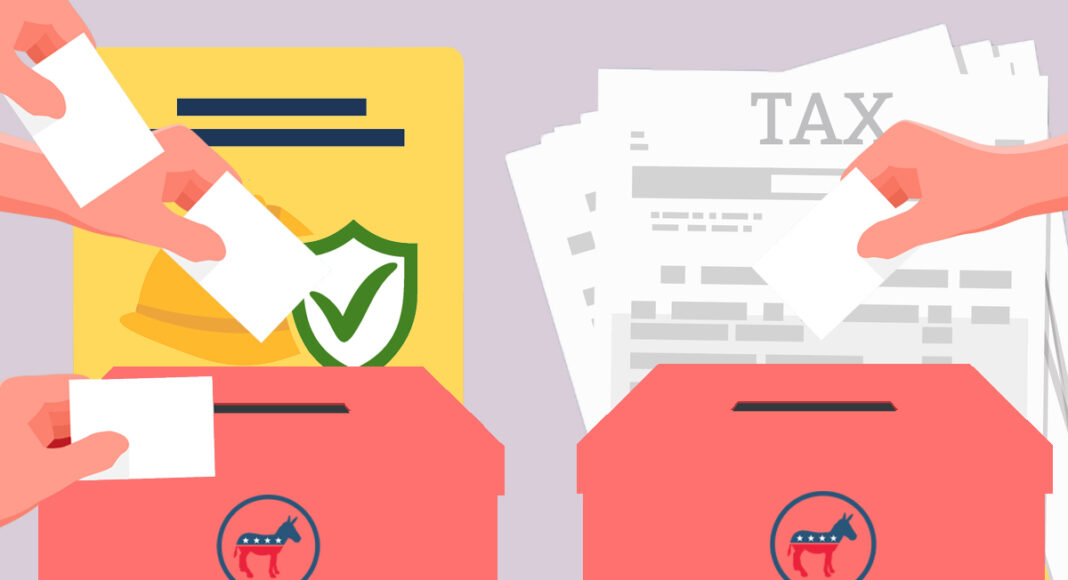In a new paper, Ilyana Kuziemko, Nicolas Longuet-Marx, and Suresh Naidu point to a shift in the Democratic Party’s economic policy, from predistribution to redistribution, as one of the reasons why it has lost less-educated voters.
A number of authors and commentators have pointed out that center-left parties throughout the Western democracies have “upskilled” since the 1970s, or replaced their traditional, blue-collar base with an increasingly educated one. Existing explanations for this realignment tend to place responsibility on the parties’ progressive positions on cultural or social issues, such as climate change or LGBTQ+ rights. These scholars and pundits wonder if “America has become too rich for class politics.” In our new paper, “Compensate the Losers,” we ask if economic policies instead explain the United States’ Democratic Party’s loss of “less-educated” voters. We define “less-educated” as individuals with fewer years of education compared to their generational peers, rather than as a categorization of pure educational attainment (such as a college degree).
In our paper, we find class politics remains important to understanding changes in party membership. Specifically, when it comes to distributional policies, less-educated individuals prefer “predistribution” (e.g., labor market interventions such as the minimum wage, unions, protectionism, trade policies, and public employment) and well-educated individuals prefer “redistribution” (tax and transfer spending), policies that could be seen as compensating the “losers” of market liberalization or trade opening. The Democratic Party’s shift towards redistribution over predistribution helps explain its loss of less-educated voters. Using more than 200 historical polling datasets asking opinions about policies dating back to the 1940s, we show that this relationship between education and economic policy preferences is stable and shows no change even as less-educated voters stop identifying with the Democratic Party.
Figure 1. Preferences for pre- and re-distribution by education

Note: This graph shows the coefficients of a linear regression of policy preferences on respondent’s years of schooling.
In 1945, an additional year of education was associated with a decline in the probability to be in favor of “providing jobs for all” by 5% of a standard deviation; this relationship has stayed mostly constant until today. In contrast, an additional year of schooling has been associated with an increase in the probability to support “taxing the rich” by about 1% of a standard deviation.
While Democrats of the New Deal Era promoted many predistributionist policies—the 1935 Wagner Act legalized and promoted organized labor, the 1938 Fair Labor Standards Act introduced a federal minimum wage, and President Franklin D. Roosevelt and other Democrats created the Works Progress Administration and other federal employment programs to maintain full employment—we argue that the Democrats moved away from these ideas beginning in the 1970s. Before the 1970s, predistribution-related topics accounted for nearly 20% of House votes in years the Democrats controlled the Speakership, but since then for only 10%. The redistribution share, in contrast, holds steady. Using natural language processing techniques, we find a similar 1970s-era decline in pre- versus redistributionist language in Democratic Party platforms.
This shift away from predistribution coincided with the rise of a faction within the Democratic Party that called themselves the “New Democrats” and would eventually form a more official organization called the Democratic Leadership Council (DLC), as depicted in Figure 2. We analyze vote patterns to show that this faction was generally more conservative than other Democrats but especially so on predistribution topics.
Figure 2. Evolution of Democratic Leadership Council (DLC) membership in Congress

Note: This graph shows the evolution of the proportion of the House Democratic caucus belonging to the Democratic Leadership Council.
As a proximate cause of the emergence of these New Democrats, we provide evidence that educated donors have started to play an increasingly important role in Democratic primary races relative to Republican primary races. This shift is partly due to reforms of the Federal Election Commission (as well as party reforms) in the 1970s, which reduced the political influence of labor unions. In particular, we document a rise in out-of-district donations by educated individuals in Democratic primaries, meaning educated people who cannot vote for candidates are playing a larger role in selecting who will represent the Democrats in the general election. It is thus not surprising that they are choosing candidates that better appeal to educated voters like themselves.
Figure 3. Average level of schooling of primary dollars for House elections…
Figure 3a. By Out-of-District Contributors
Figure 3b. By Within-District Contributors


Note: These graphs show the average education level of primary contributors. The left graph shows the average education of out-of-district contributors while the right graph shows the within-district contributors.
While comprehensive donations data are only available since 1980, we can observe the changing faces of the parties by examining the biographies of Congress members themselves. In the decades immediately after World War II, Republican legislators were significantly more likely to hail from Ivy League universities. The reverse is true today, with the inflection point again occurring in the 1970s. During the same decade, Democrats in their Congressional speeches began to speak in a manner requiring higher levels of education to be understood relative to Republicans.
Finally, we study how voters have reacted to this change in the Democratic party. We harmonized more than 800 surveys to show that the educational gradient in party identification has been quite stable until an inflection point that we estimate as occurring in 1976 (Figure 4). Since then, the educational gradient in Democratic partisanship has been on a constant rise. While until 1976, every additional year of education predicted a three percentage point decrease in the likelihood of identifying as a Democrat, the exact opposite is true today–every additional year of education predicts almost a three percentage point increase in the likelihood of identifying as a Democrat.
Figure 4. Democratic Party identification as a function of education

Note: This graph shows the coefficient of a linear regression of Democratic identification on years of schooling. Until 1976, an additional year of schooling was associated with about a 2.5 percentage point decline in the probability to identify as Democrat. It started to increase in 1976 and today, each additional year of schooling is associated with an increase in the probability to identify as Democrat by about 2.5 percentage points.
We then provide evidence that the shift towards the New Democrat faction of the party has been met with consistent disapproval from the least-educated voters, indicating a clear disconnect between this demographic and the evolving political stance of the party. Looking at hypothetical candidate matchup questions, we find that less-educated voters were more likely to say that they favored a Republican presidential candidate when the hypothetical other choice was a “New Democrat” candidate like Jimmy Carter, Gary Hart, or Bill Clinton, rather than an “Old Democrat” like Ted Kennedy, Jesse Jackson, or Walter Mondale. We also look directly at voting outcomes for House elections and find that less-educated neighborhoods are less likely to vote for the Democratic candidate when they are DLC-affiliated.
Obviously, there were many other changes in the Democrats’ political platform during this same period that could explain this realignment, and we cover several of them in the paper. In particular, we provide arguments to rule out that social issues alone have been the driving force of this realignment since the 1970s. First, we show that Democrats’ increasingly liberal positions on Civil Rights since the 1940s have actually led them to lose better-educated white Southern voters rather than less-educated white Southern voters. Second, our survey data shows that better-educated Democratic voters tend to be more liberal on social issues. Given DLC Democrats were socially more conservative, the differential support they got from educated voters was in spite of their social stances.
We also discuss the changes in the Republican party during the decades after WWII, such as the rise in Southern and evangelical factions, and argue these were unlikely to drive this realignment along class lines. We indeed find that less-educated voters’ preference for the Republicans does not change until the 1990s, around the time when Republicans took the House.
In summary, we argue that the Democratic Party’s economic policy shifts have played a significant role in the partisan realignment that has occurred in the United States over the past few decades. This is not the entire story, as we find that at most half of the party’s realignment toward better-educated voters can be attributed to voters’ perceptions of the party’s economic policies. Our research’s interpretation is that economic policy, when distinguished between predistribution and redistribution, is an underappreciated determinant of partisan realignment by education. We conclude that, at least in the United States, class politics is still alive and well.
Articles represent the opinions of their writers, not necessarily those of ProMarket, the University of Chicago, the Booth School of Business, or its faculty.






